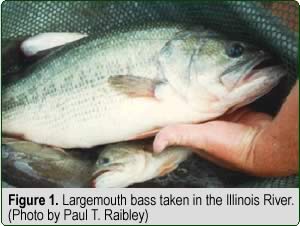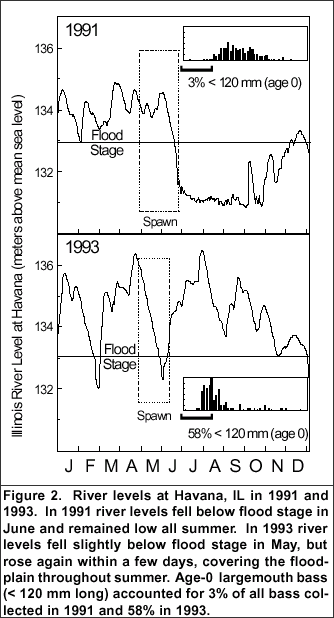|
PSR 97-03 May 1997 River Levels and Largemouth Bass Populations in the Illinois River1by Paul T. Raibley2 and Richard E. Sparks3 |
|
Although the population dynamics of largemouth bass Micropterus
salmoides (Figure 1) in ponds, lakes, and reservoirs have been
studied extensively, less is known about largemouth bass population
dynamics in temperate, large river-floodplain ecosystems. |
|
We examined the relationship of river level and temperature to largemouth bass population structure in La Grange Reach (a 125.6-km segment between La Grange Lock & Dam and Peoria Lock & Dam) of the Illinois River from 1990 to 1995. Fish were collected with a pulsed-DC electrofishing boat along randomly selected segments of backwater, side channel, and main channel shoreline as part of the Long Term Resource Monitoring Program (LTRMP). Each year sampling was conducted between 15 June and 30 October with effort distributed uniformly throughout the sample season. We used the percent of the fish less than 120 mm (5 inches) long from each year’s sample as an index of year class strength for young-of-the-year (age-0) fish. Of 218 bass we aged since 1993 that were less than 120 mm long, 96.8% were age 0. We made 591 electrofishing collections (150.6 hours) from 1990
through 1995 and collected a total of 2,563 bass. In three of the
six years (1990, 1993 and 1995) age-0 fish made up more than 20%
of the total catch indicating strong year classes were produced.
These year classes remained strong in subsequent years as evidenced
by their presence in our annual collections. Flood waters coincided
with warming water temperatures and bass spawning times in each
of these years. In 1993 water covered the floodplain |
|
Over the past six years we have gained insight into the relationship between spring river levels and fish production in La Grange Reach, but our knowledge is still lacking in many areas. For example, what are the effects of droughts on fish populations in La Grange Reach? As we continue to monitor Illinois River fish populations and other LTRMP biologists continue to monitor Mississippi River fish populations, our understanding of fish population dynamics in temperate, large river-floodplain ecosystems will improve. 1Expanded from Illinois Natural History Survey Reports No. 344, March/April 1997. |
|
|
|
This report is a product of the Long Term Resource Monitoring Program for the Upper Mississippi River System. For further information, contact 2Paul T. Raibley 3Richard E. Sparks U.S. Geological Survey
Project Status Reports (PSRs) are preliminary documents whose purpose is to provide information on scientific activities. Because PSRs are only subject to internal peer review, they may not be cited. Use of trade names does not imply U.S. Government endorsement of commercial products. All Project Status Reports are accessible through the Upper Midwest Environmental Sciences Center’s website at http://umesc.usgs.gov/reports_publications/psrs/umesc_psr.html |
Page Last Modified: April 17, 2018


 River levels likely affect fish populations in these systems during
certain times of the year (e.g. spawning) because they can determine
habitat availability and quality. Because river level regimes vary
annually, long-term data sets are needed to understand fish population
dynamics in these systems over a wide array of environmental conditions.
River levels likely affect fish populations in these systems during
certain times of the year (e.g. spawning) because they can determine
habitat availability and quality. Because river level regimes vary
annually, long-term data sets are needed to understand fish population
dynamics in these systems over a wide array of environmental conditions.
 (Figure
2) for nearly nine months (March through October), greatly expanding
spawning and nursery habitat which resulted in high fish production
and low mortality; age-0 bass comprised 58.3% of our catch that
year. Although river levels fell during spawning in 1993, the floodplain
remained inundated throughout most of that time and river levels
remained low for only a few days before rising again, reinundating
the floodplain. As a result, bass mortality due to nest abandonment
and stranding may have been low.
(Figure
2) for nearly nine months (March through October), greatly expanding
spawning and nursery habitat which resulted in high fish production
and low mortality; age-0 bass comprised 58.3% of our catch that
year. Although river levels fell during spawning in 1993, the floodplain
remained inundated throughout most of that time and river levels
remained low for only a few days before rising again, reinundating
the floodplain. As a result, bass mortality due to nest abandonment
and stranding may have been low.